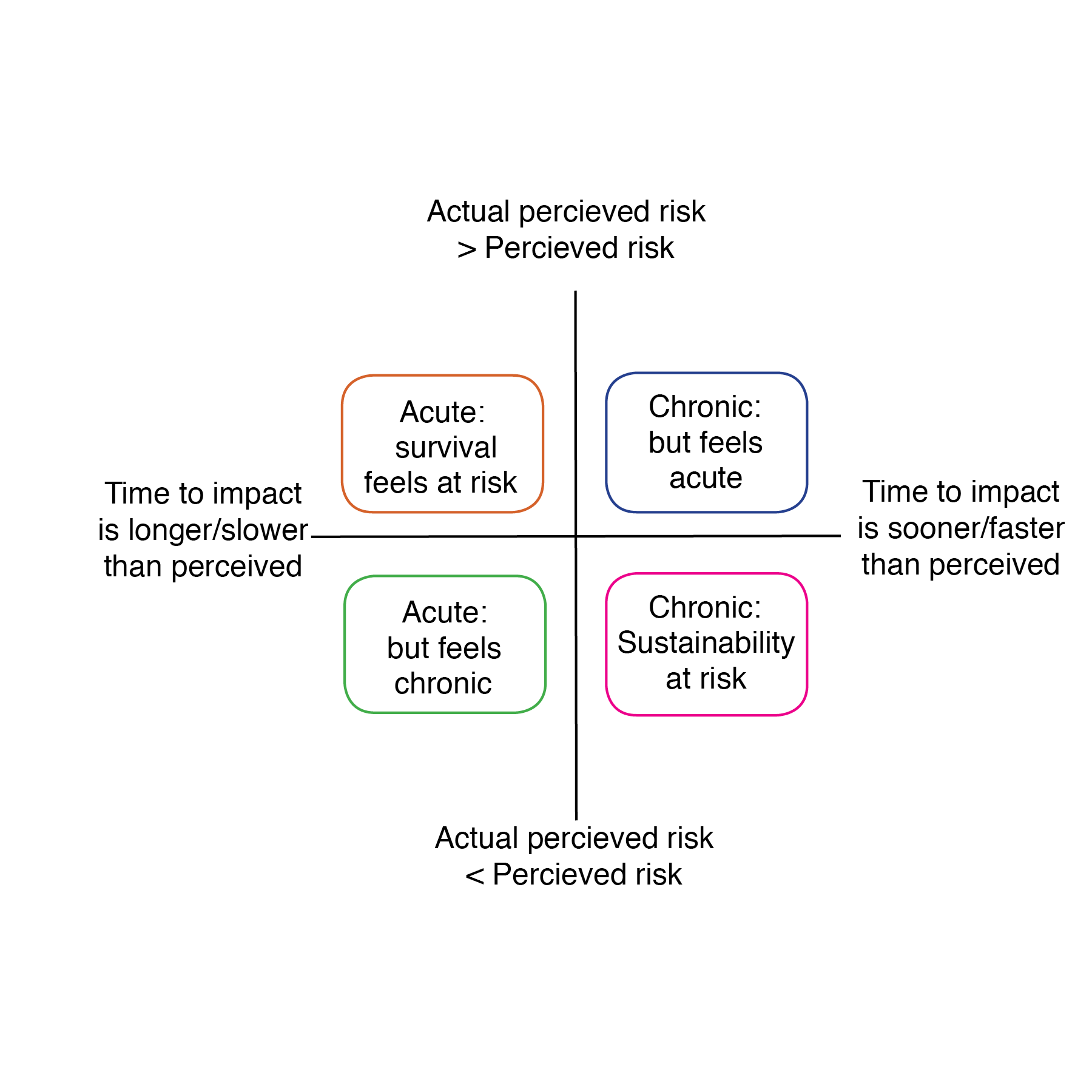By Lisa Taylor
Last March, my work was interrupted by a health issue. I often describe what happened to friends as a chronic underlying condition that had suddenly become acute.
But that’s not really true.
I do have a chronic health condition that is as much a part of me as my red hair. Used to navigating complications, I allowed worrying symptoms to continue as my doctor slowly searched for underlying causes. Then, a fresh set of eyes on my data sparked swift and immediate action. In less than 20 minutes what had been a slow, persistent exploration became a comprehensive disruption. All attention shifted to what was suddenly understood to be acute and urgent.
I am happy to report that the issues have shifted back from being acute to chronic. I am grateful to the doctors who took swift action and collaborated to find immediate urgent solutions. I am just as grateful to those same doctors for knowing when and how to let go, allow other specialists to step forward and implement plans that can be sustained over the long term for a situation that is no longer urgent—but is persistent, long-lasting, and important.
Chronic versus acute approaches to workforce challenges
Sometimes it feels like change is coming at us too quickly. Other times, we can see trends looming over the horizon and if feels like it is taking forever for them to finally, actually arrive. Organizations can benefit from a deeper understanding of how healthcare approaches uncertainty. As we look ahead at what’s to come in 2018, 2020 and, indeed, 2030, we have found that taking a chronic versus acute approach helps to set priorities, and make sense of a changing world.
Challenge Factory’s five drivers shaping the Future of Work focus on the specific business impact of (1) shifting demographics, (2) career ownership, (3) the freelance economy, (4) new platform-based business models, and (5) AI, robotics, and jobs of the future. I’ve presented this model more than a dozen times to leaders in different sectors, from electricity distribution to financial services to social workers. What unites each of the diverse industries we work with is a clear need for a map to help make sense of the shifts and changes impacting the world of work.
Between now and 2030, there are a lot of changes coming that will impact individual career paths and potential, workforce strategy, industry dynamics, and social expectations of work and life. Some are acute and urgent, putting your business at risk today. Others are chronic and important, threatening future sustainability and needing longer term solutions.
Treating acute or chronic issues with the wrong type of solution can be disastrous. Survival and sustainability can be put at risk:
 Your organization is facing both acute and chronic workforce challenges.
Your organization is facing both acute and chronic workforce challenges.
Recently, one of our clients had a key member of their leadership team suddenly announce his retirement. His knowledge and networks are foundational to how the company operates and its culture, client projects and operational efficiencies were immediately at risk. The retirement announcement presented an urgent, acute threat. We are assisting with specific, targeted knowledge translation and workplace culture services to address the immediate problem. The company is also looking at how they can implement sustainable, comprehensive and persistent new approaches to how they prepare and address impending retirements. Together, we are addressing the underlying chronic condition to minimize the occurrence of future acute events.
Preparing for the workforce of 2020 and beyond requires accurate monitors, clear baselines, and the ability to shift approaches and priorities without losing site of the overall goal: a supercharged workforce that will be your competitive advantage.
3 steps to diagnose your workforce challenges
1. Separate perception from reality. Common wisdom in sales and communications circles is that perception is reality – that what people perceive to be true is true. However, when setting workforce strategies that will take you to 2020 and beyond you need to be focused on actual projections for your industry, adjacent sectors and geography. Often, topics that get the most attention in mainstream media feel like they are the most urgent. But this perception is based on editorial perspective, not your business’ truth.
Ask yourself: Does it feel like your new workforce related initiatives are a “flavour of the month?” Are they high priority and topical for a short period of time, but don’t actually fulfil the initial promises made? If so, you may be addressing important, persistent issues (chronic) with an acute communications strategy.
2. Let the data share its secrets. We know that predicting the future is not like completing a puzzle. We will never have all the pieces in front of us to work with and the frame or border pieces will never remain static. Instead, we approach every organization and challenge as scientists, looking for clues to solve the Future of Work mysteries as they unfold. We start with the data and facts on hand. We integrate our broad understanding of the world of work, across sectors, geographies, and cultures. We look for the clues that will unlock potential within your organization and supercharge your workforce programs.
Ask yourself: Are you using the data available to you to guide your strategy and priority programs? There are techniques for organizations of all sizes to use data to make better decisions. Without the facts, there is a dangerous tendency to over- or underestimate impact and urgency.
3. Value the balance between specialists and generalists. Challenge Factory is not like other consulting firms: our central purpose and expertise is tied to one question: What is the Future of Work? We take a 360°, multidisciplinary approach to this issue with teams of specialists from the fields of strategy development, HR, talent management, demographics, neuroscience, workforce planning, learning and development, adult learning and education, analytics, design thinking, agile program management, and research.
Ask us: which of your issues are urgent and need specific, immediate attention led by the right expert? Which symptoms and issues are actually more persistent, requiring efficient collaboration between specialists to identify and implement a plan that introduces change in healthy and sustainable ways?
Navigating the Future of Work requires both urgent and persistent interventions. Capitalizing on its potential requires that leaders know the difference. Change is a chronic condition and needs to be managed with a goal focused on sustainability. Fatigue sets in when change is treated as if it is endlessly acute—always urgent and with survival seemingly always at risk.
Challenge Factory understands the Future of Work. We supercharge your workforce strategy and programs, addressing the acute and chronic dynamics of shifting demographics, career ownership, the freelance economy, new business models, and preparing for the jobs of the future.
